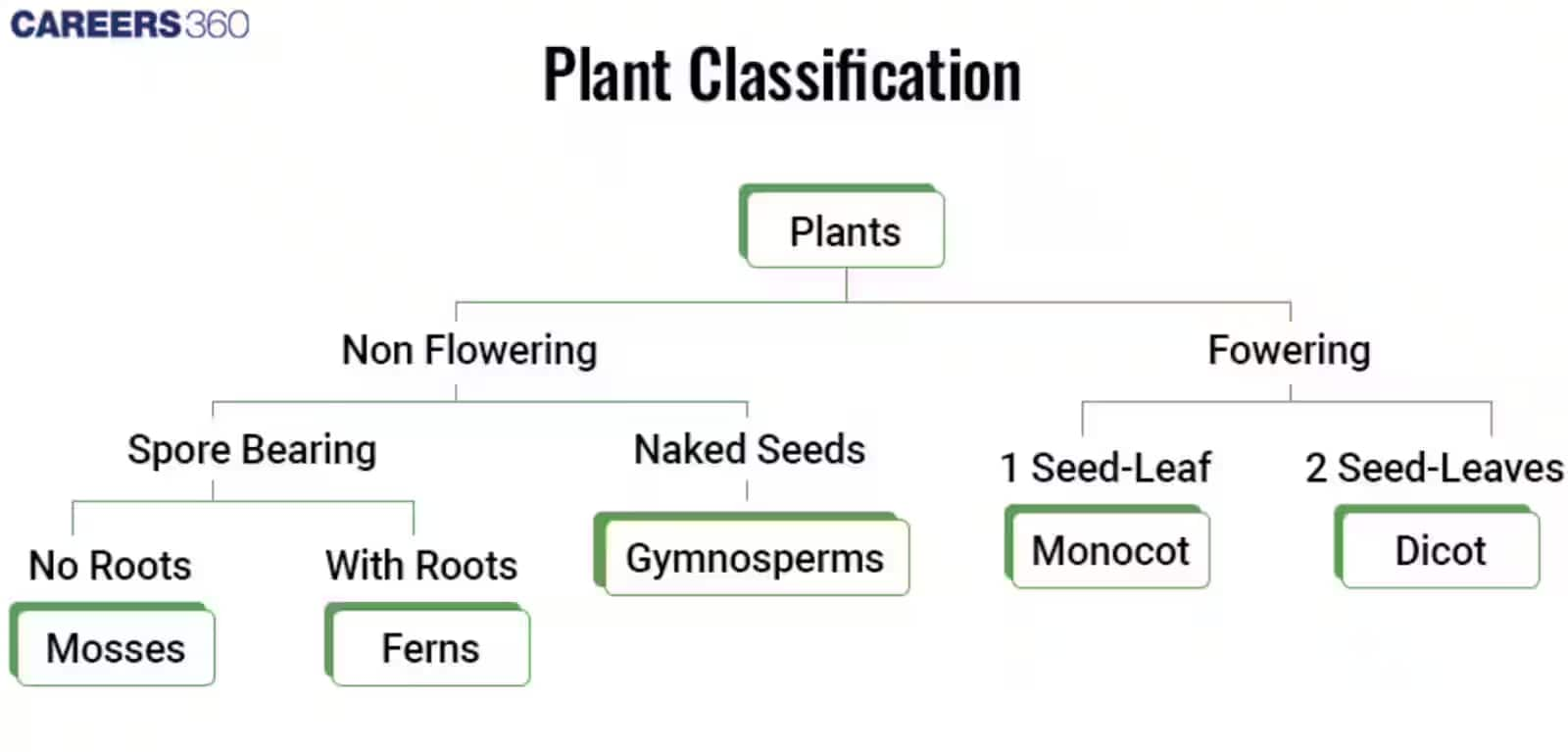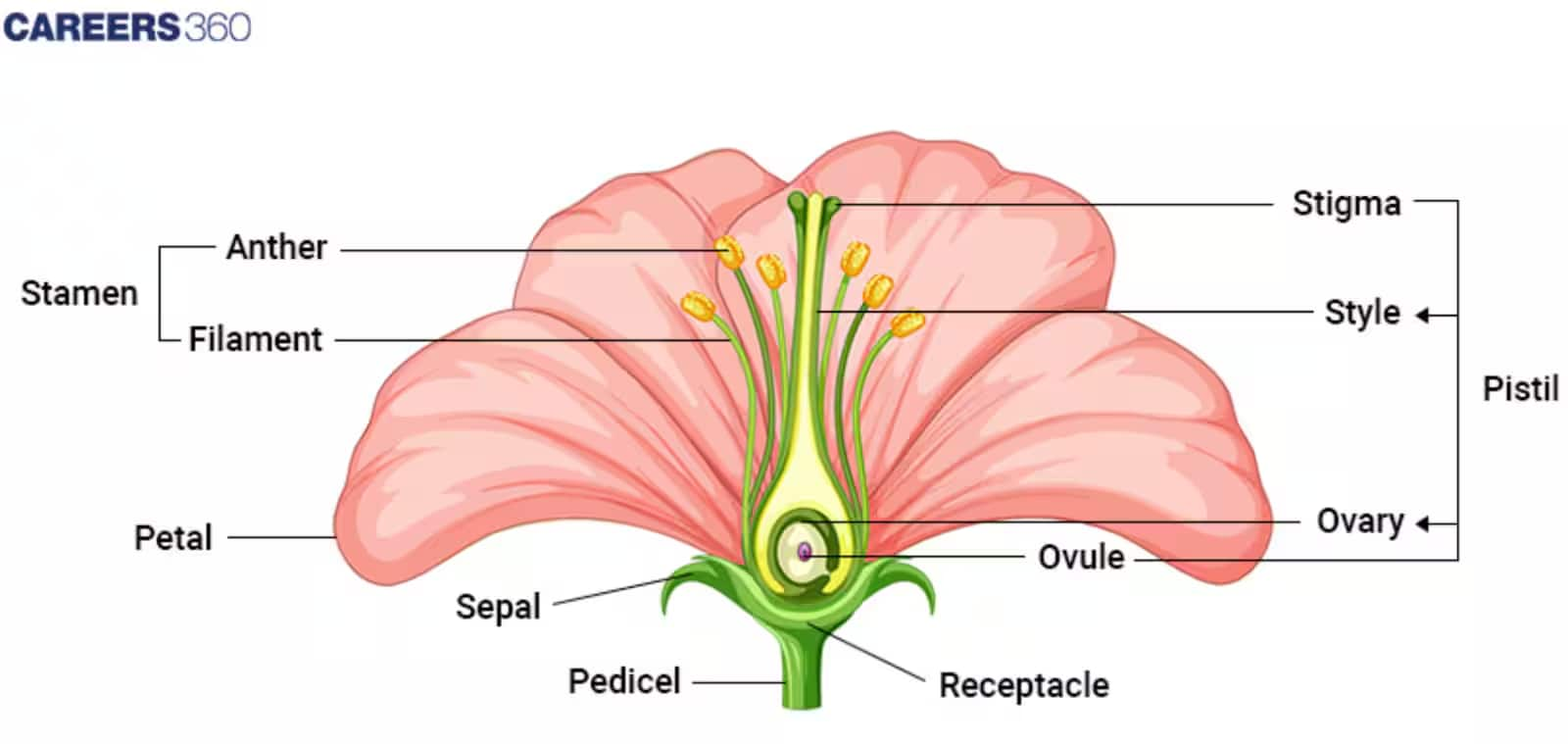- Class 11 Biology Chapter 3 Plant Kingdom Notes PDF includes well-labeled diagrams of algae, bryophytes, pteridophytes, etc, for easy understanding.
- The notes explain the features and classification of all plant groups clearly, which are important for school exams and competitive exams like NEET.
- All the important terms, examples, and differences are highlighted using the flowcharts, by which students can memorise quickly and retain concepts better.
- Different life cycles and alternation of generations are included with detailed explanations to help students perform well.
NCERT Class 11 Biology Chapter 3 Notes Plant Kingdom- Download PDF Notes
Did you know that plants, which look so familiar, actually represent one of the most complex systems on our planet? The NCERT Class 11 Biology Chapter 3 Notes Plant Kingdom explores the interesting classification of plants, from simple algae to flowering angiosperms. It includes simple and clear points, well-labelled diagrams, and previous-year questions with answers. The NCERT Notes are a valuable resource for self-study to get the best results in the board exams as well as competitive exams like NEET.
This Story also Contains
- NCERT Class 11 Biology Chapter 3 Plant Kingdom Notes: Download PDF
- Class 11 Biology Chapter 3 Plant Kingdom Notes
- Plant Kingdom: Previous Year Questions and Answers
- How to Use Plant Kingdom Class 11 Notes Effectively?
- Advantages of Class 11 Biology Chapter 3 Plant Kingdom Notes
- Chapter-Wise NCERT Class 11 Notes Biology
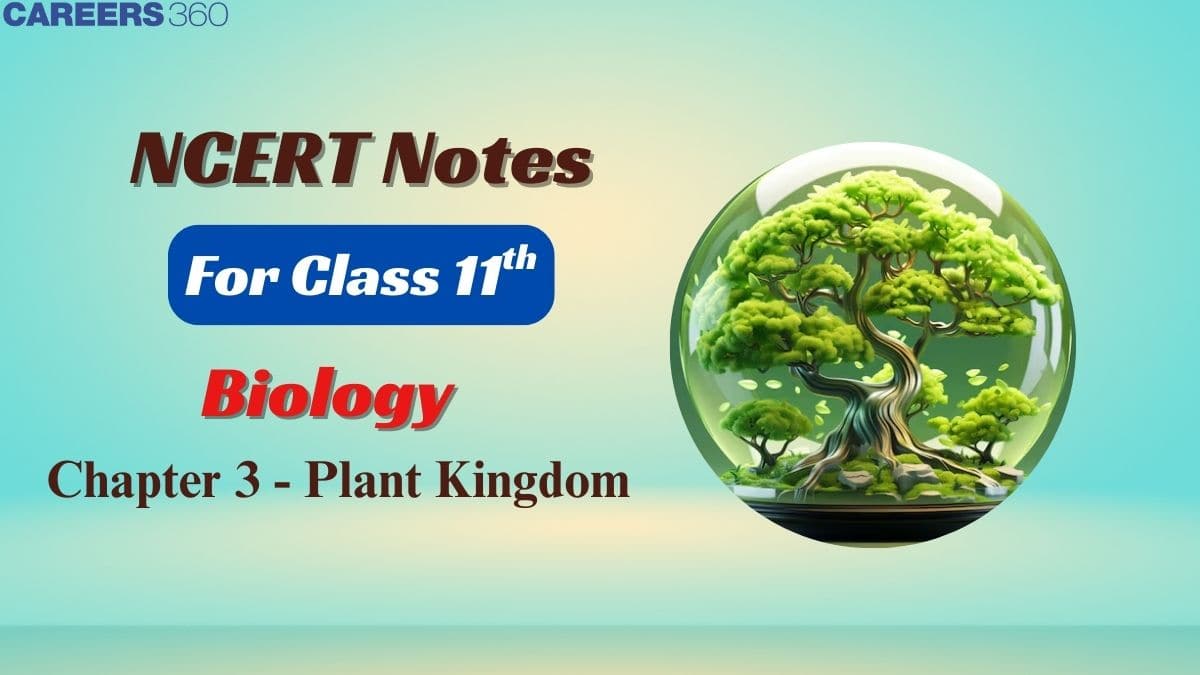
The NCERT Class 11 Biology Chapter 3 Notes explain important differences among algae, bryophytes, pteridophytes, gymnosperms, and angiosperms. The notes also highlight how features, evolutionary importance, reproduction, and alternation of generations vary across these groups, supported by diagrams. With the help of these NCERT Notes for Class 11, students will be able to answer questions very confidently and do well in their exams.
NCERT Class 11 Biology Chapter 3 Plant Kingdom Notes: Download PDF
This chapter explains how plants are grouped into categories, like algae, bryophytes, pteridophytes, gymnosperms, and angiosperms. Students can download the PDF of NCERT Class 11 Biology Chapter 3 Notes. Reading everything from the textbook can be time-consuming, so having NCERT Notes for Class 11 Biology improves the learning.
Also Read:
Class 11 Biology Chapter 3 Plant Kingdom Notes
Here, students will get a simple, clear explanation of each group of plants, from algae to angiosperms. The Plant Kingdom Class 11 Notes are prepared by subject experts following the NCERT curriculum, which helps students revise quickly. They can understand the complex topics easily and be ready to solve any kind of questions based on this chapter.
Introduction to the Plant Kingdom
The Plant kingdom covers all green plants, including algae, bryophytes, pteridophytes, gymnosperms, and angiosperms. Earlier classification placed fungi, bacteria, and cyanobacteria under plants, but now these are separated. Classification has evolved from simple characters (e.g., shape, colour) to modern phylogenetic systems using molecular, cytological, and chemical data.
Algae
- Simple, thalloid, chlorophyll-bearing, mostly aquatic organisms.
- Found in freshwater, marine water, moist soil, and even on animals.
- Reproduce vegetatively (fragmentation), asexually (zoospores), and sexually (isogamy, anisogamy, oogamy).
- Important because they fix CO2, produce oxygen, and are primary producers in aquatic food chains.
- Economic uses: food (Porphyra, Laminaria), hydrocolloids (algin, carrageenan), agar (microbiology and food industry), Chlorella as a protein supplement.
- Examples of algae (Volvox, Spirogyra, Fucus)
Classes of Algae
The different classes of algae have been discussed below:
Chlorophyceae (Green Algae):
- Grass-green due to chlorophyll a & b
- Food is stored as starch in pyrenoids
- Cell wall of cellulose + pectin
- E.g., Chlamydomonas, Volvox, Spirogyra

Phaeophyceae (Brown Algae):
- Olive-green to brown due to fucoxanthin
- Stored food: laminarin or mannitol
- Cell wall with cellulose + algin
- Usually marine, large-sized (kelps)
- E.g., Laminaria, Fucus
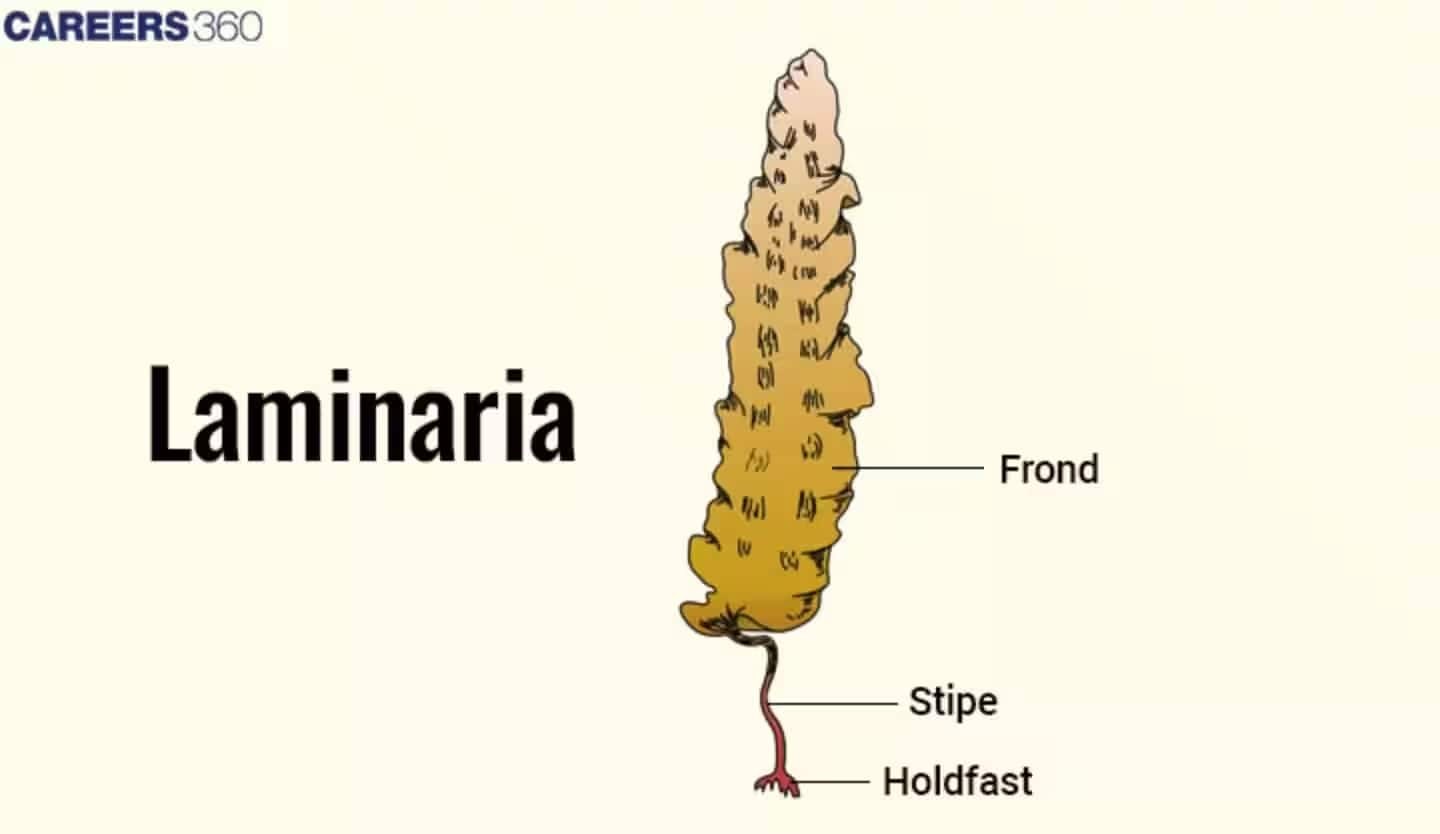
Rhodophyceae (Red Algae):
- Red pigment r-phycoerythrin
- Store food as a flouridean starch
- Mostly marine
- E.g., Polysiphonia, Porphyra, Gelidium, corallina
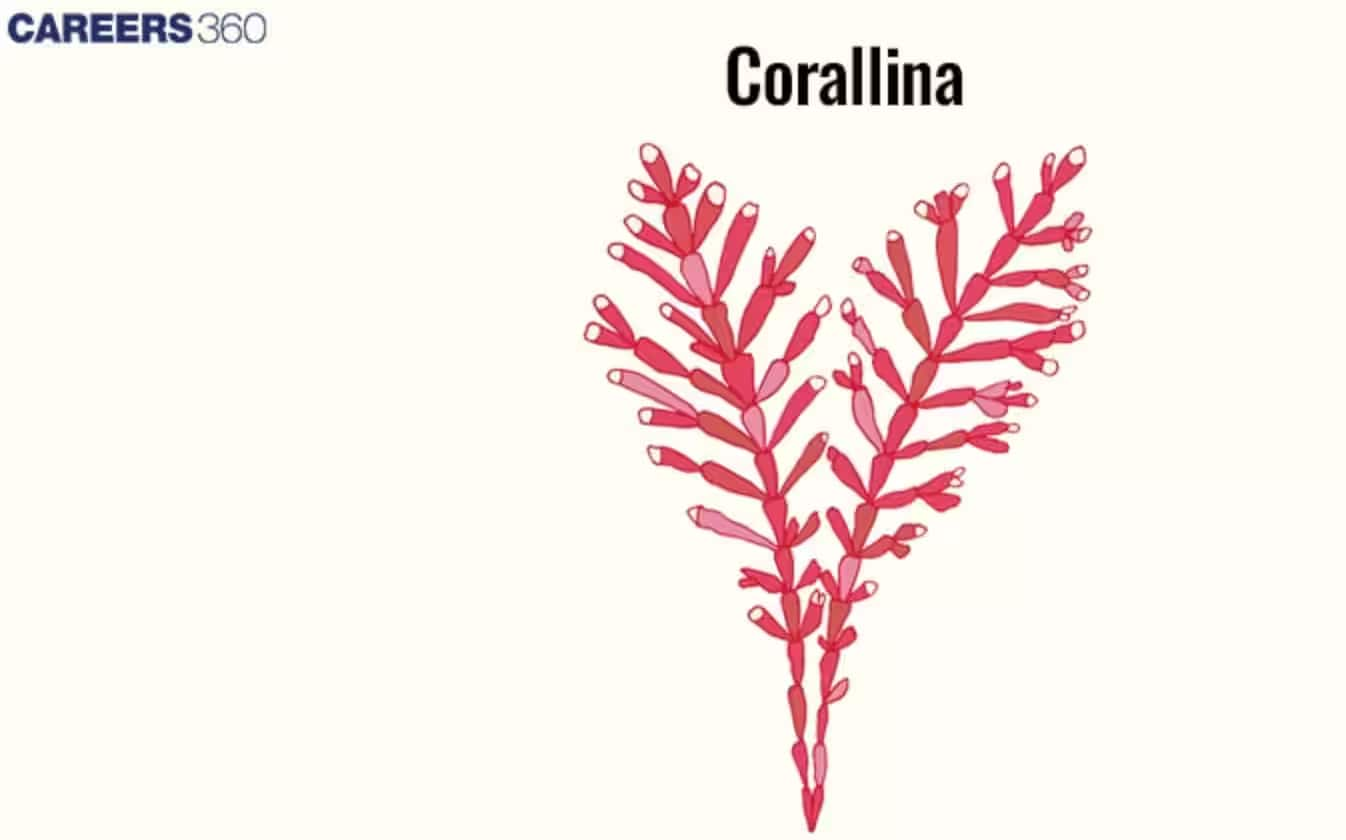
Bryophytes
- The bryophytes are called “amphibians of the plant kingdom” as they live on land but need water to reproduce.
- Occur in moist, shaded areas
- Main plant body: gametophyte (haploid), produces gametes
- The sporophyte is attached to and dependent on the gametophyte
- E.g., liverwort, hornwort, mosses
Liverworts
- Thalloid, dorsiventral structure
- Asexual reproduction by fragmentation or gemmae in gemma cups
- E.g., Marchantia
Mosses
- The gametophyte has two stages: protonema (creeping) and the leafy stage
- Reproduce vegetatively by fragmentation
- E.g., Funaria, Polytrichum
Pteridophytes
- First land plants with vascular tissues (xylem + phloem)
- True root, stem, and leaves present
- The dominant plant body is the sporophyte
- Reproduce via spores; the gametophyte is independent but small
- Show heterospory in genera like Selaginella, leading to seed habit evolution
- E.g., Selaginella, Equisetum
Gymnosperms
- Seeds are “naked” (no fruit covering)
- Ovules exposed before and after fertilisation
- Usually large trees or shrubs (e.g., Pinus, Cycas, Sequoia)
- Well-adapted leaves, tap roots, and cones
- Heterosporous, with separate male and female cones
- Male gametophyte = pollen grain
- The female gametophyte develops inside the ovule
- E.g., Pinus, Ginkgo
Angiosperms
- Most advanced plants, with flowers
- Ovules are enclosed in ovaries, forming fruits after fertilisation
- The largest group in the plant kingdom
- Provide food, medicine, timber, etc.
- Classified as dicots (two cotyledons) and monocots (one cotyledon)
- E.g., Wheat, Mustard, Rice
Characteristics of the Plant Kingdom
The plants make their food through photosynthesis, have cell walls made of cellulose, and store food in the form of starch. They are necessary for maintaining oxygen levels and forming the foundation of food chains. The following points show the important features of the Plant Kingdom:
- Plants are made up of many specialised cells that form tissues and organs.
- They make their food using sunlight with the help of chlorophyll (types a and b).
- Their cells have walls made of cellulose, providing rigidity and protection.
- Chlorophyll a and b help absorb light efficiently for photosynthesis.
Reproductive Features of the Plant Kingdom
Types of reproduction include sexual reproduction and asexual reproduction, depending on the group. Alternation of generations is a common pattern in their life cycles. It includes two distinct multicellular phases:
- Produces haploid gametes (egg and sperm)
- Forms sporophytes after fertilisation of gametes diploid), produces spores through meiosis.
This alternation maintains genetic diversity and provides the continuation of the plant life cycle.
Physiological Features of the Plant Kingdom
Plants perform essential physiological processes that maintain growth, development, and their relationship with the environment. These include:
- Photosynthesis is important for getting energy for the metabolic activities of plants and for the synthesis of oxygen used in aerobic respiration by living beings.
- Through cellular respiration, plant cells can split glucose molecules and release free energy for use in other cellular processes. This process, called cellular respiration, takes place in the mitochondria, where oxygen is used in the process and carbon dioxide and water are formed as waste.
- Plants use stomata to release water vapour by transpiration, regulating temperature and promoting nutrient flow for growth.
Also, Read
Plant Kingdom: Previous Year Questions and Answers
Some of the questions that have come in past years from the chapter are given below. Students preparing for exams can also practice from the Plant Kingdom Class 11 Notes for better clarity.
Question 1. The giant Redwood tree (Sequoia sempervirens) is a/an
Option 1. Gymnosperm
Option 2. Free fern
Option 3. Pteridophyte
Option 4. Angiosperm
Answer :
Redwood trees are a Gymnosperm that have earned many labels; known as the tallest tree, oldest tree, largest by trunk volume, etc. They belong to the Cupressaceae family and include species like the Coast Redwood and Giant Sequoia. Their towering height and immense lifespan make them iconic symbols of resilience and natural beauty.
Hence, the correct answer is option (1) Gymnosperm.
Question 2. If the diploid number of a flowering plant is 36. What would be the chromosome number in its endosperm?
Option 1. 36
Option 2. 54
Option 3. 18
Option 4. 72
Answer :
Endosperm is formed through the fusion of a haploid male gamete and a diploid secondary nucleus. Consequently, the endosperm has a triploid nucleus, which will have three times the number of chromosomes as in a haploid nucleus.
Hence, the correct answer is option (2) 54.
Question 3. Plants of this group are diploid and well-adapted to extreme conditions. They grow bearing sporophylls in compact structures called cones. The group in reference is
Option 1. Monocots
Option 2. Gymnosperms
Option 3. Pteridophytes
Option 4. Dicots
Answer :
Cones are a primary feature of gymnosperms. Furthermore, gymnosperms are admirably adapted to extreme conditions. The plants that produce seeds are called gymnosperms, although they don't have fruits like angiosperms do. These plants generate a cone-like structure at the terminal of stalks or on the surface of scales or leaves.
Hence, the correct answer is option (2) Gymnosperms.
Question 4. An alga having chlorophyll a, Floridean starch as a storage product, and lacking flagellate cells belongs to the class:
Option 1. Phaeophyceae
Option 2. Chlorophyceae
Option 3. Rhodophyceae
Option 4. Xanthophyceae
Answer :
An alga having chlorophyll a, floridean starch as a storage product, and lacking flagellate cells belongs to the class Rhodophyceae, also known as red algae. Red algae are a group of algae that typically have a red or purplish color due to the presence of pigments such as chlorophyll and accessory pigments like phycoerythrin and phycocyanin.
Hence, the correct answer is option (3) Rhodophyceae.
Question 5. The first living beings on Earth were anaerobic because
Option 1. There was no oxygen in the air
Option 2. oxygen damages proteins
Option 3. oxygen interferes with the action of ribozymes
Option 4. They evolved in the deep sea
Answer :
The first living beings on Earth were likely anaerobic organisms because the Earth's atmosphere lacked oxygen during its early stages. This period, known as the Precambrian or Archean era, lasted for billions of years before oxygen began to accumulate in the atmosphere through the process of photosynthesis by cyanobacteria.
Hence, the correct answer is option (1). There was no oxygen in the air.
Also Read:
How to Use Plant Kingdom Class 11 Notes Effectively?
Understanding the plant kingdom requires a clear revision strategy because of the detailed classification and examples involved.
Start by revising the classification levels step by step, moving from algae to angiosperms, so that concepts remain clear.
Use Class 11 Biology Chapter 3 Plant Kingdom Notes PDF to focus on key differences between different groups, as they are frequently asked in exams.
Practice diagrams of life cycles (such as bryophytes and pteridophytes) regularly to improve visual learning.
While solving previous year questions, use the Class 11 Biology Chapter 3 Plant Kingdom Notes nearby to check the terms and definitions.
Revise botanical terms and examples and practice questions to test both concept clarity and memory.
Advantages of Class 11 Biology Chapter 3 Plant Kingdom Notes
Well-prepared notes allow students to understand the complete chapter of the Plant Kingdom with clarity. The notes offer many advantages, and some of them are listed below:
Chapter-Wise NCERT Class 11 Notes Biology
Given below are the notes of each chapter, which provide a clear and concise summary of each chapter, making it easier for students to revise important concepts for exams.
Frequently Asked Questions (FAQs)
The production of two different types of spores in the same plant is known as heterosporous.
Importance of heterospory according to the NCERT Class 11 Biology Chapter 3 Notes Plant Kingdom:
Heterosporous is responsible for the development of seeds in gymnosperms and angiosperms. It is necessary for the separation of male and female gametophytes.
Examples include Spirogyra (Algae), Funaria (Bryophyte), Selaginella (Pteridophyte), Pinus (Gymnosperm), and Mango (Angiosperm). These examples help students easily identify plant groups during exams.
Students can use flowcharts, tables, and mnemonic tricks to remember the hierarchy and characteristics of each plant group. Regular revision through diagrams and NCERT-based notes also improves retention.
The following are the topics that are discussed in the NCERT Class 11 Biology Chapter 3 Notes Plant Kingdom.
1. Algae
2. Bryophytes
3. Pteridophytes
4. Gymnosperms
5. Angiosperms
Subject specialists have created NCERT Class 11 Biology Chapter 3 Plant Kingdom Notes that will give you further information about the chapter. The segment explores every concept of the Plant Kingdom.
The presence or lack of pigments is the primary foundation for classifying algae. The categorisation is as follows:
- Chlorophyceae: Green algae are members of the Chlorophyceae family. Because chlorophyll a and b pigments predominate, they are usually grass green.
- Phaeophyceae: Brown algae, also known as Phaeophyceae, are mostly found in marine environments. Chlorophyll a, c, carotenoids, and xanthophylls are all present in them.
- Rhodophyceae: Rhodophyceae members are usually referred to as red algae due to the preponderance of the red pigment r-phycoerythrin in their bodies.
One of the most essential topics in the NEET exam is the Plant Kingdom. The NCERT Class 11 Biology Chapter 3 Notes Plant Kingdom are very important in biology, and you must have sufficient and in-depth knowledge and understanding of the concept in order to achieve good scores in exams.
Courses After 12th
Applications for Admissions are open.
As per latest syllabus. Physics formulas, equations, & laws of class 11 & 12th chapters
JEE Main Important Chemistry formulas
Get nowAs per latest syllabus. Chemistry formulas, equations, & laws of class 11 & 12th chapters
JEE Main high scoring chapters and topics
Get nowAs per latest 2024 syllabus. Study 40% syllabus and score upto 100% marks in JEE
JEE Main Important Mathematics Formulas
Get nowAs per latest syllabus. Maths formulas, equations, & theorems of class 11 & 12th chapters
